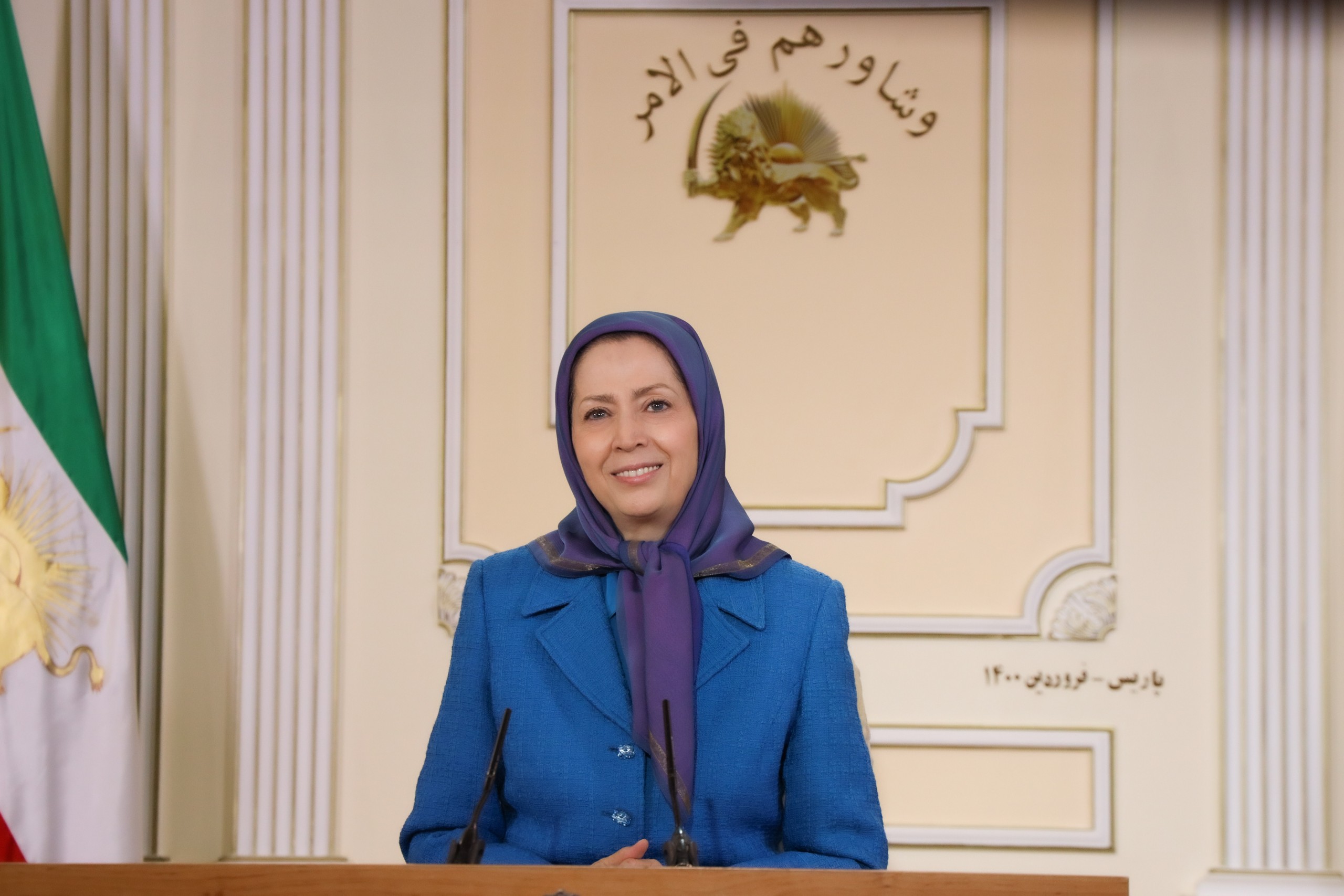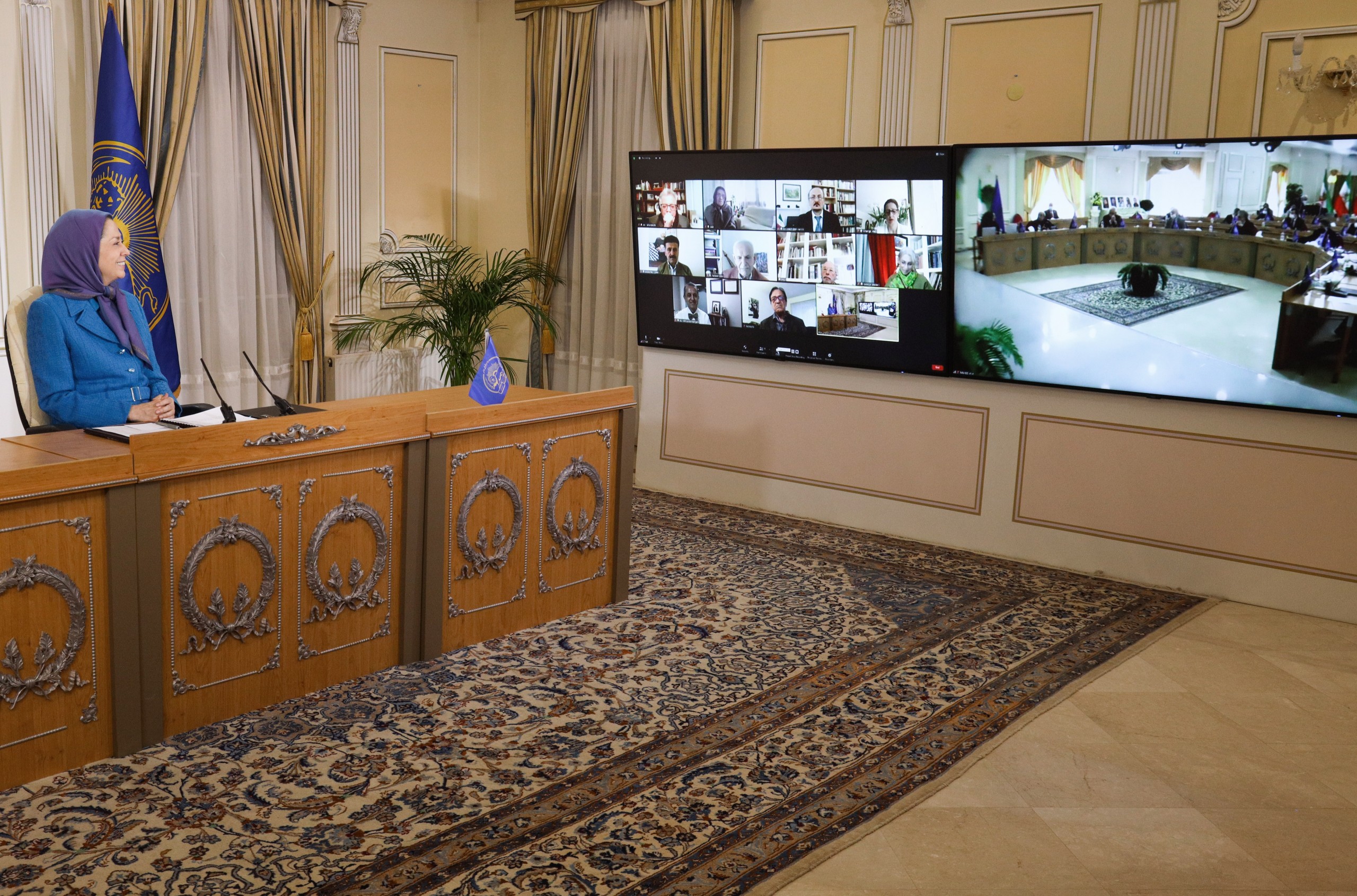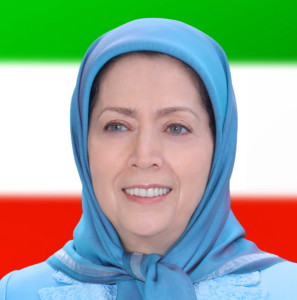Maryam Rajavi: Revolutionary circumstances exist in Iranian society as the sole democratic alternative shines ever brighter
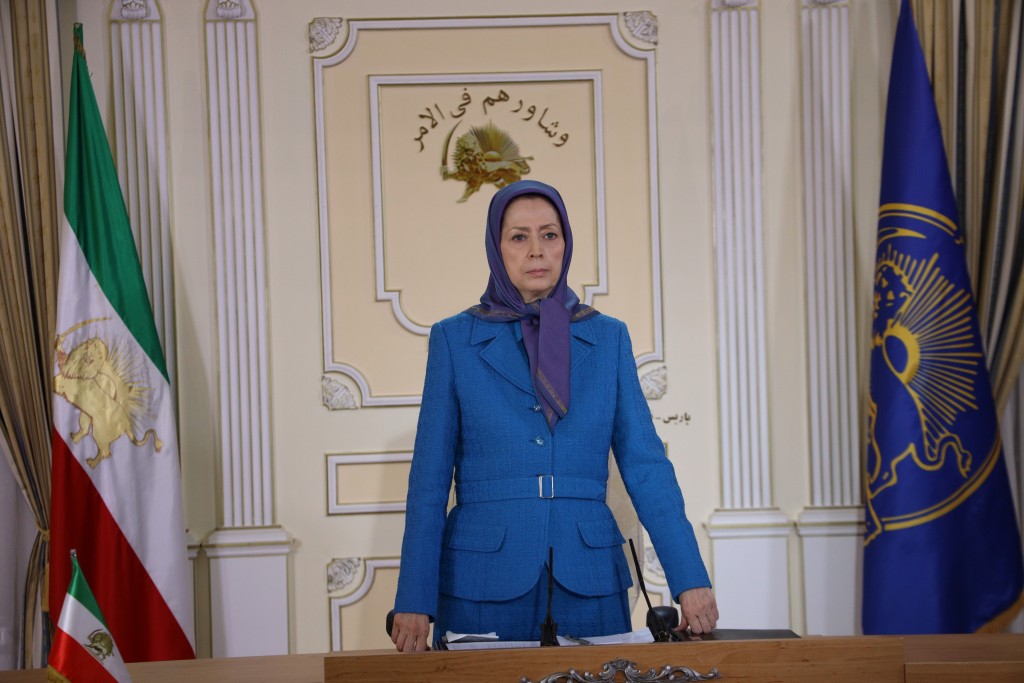
Auvers-Sur-Oise, France
NCRI interim session
Greetings and congratulations once again for Nowruz to all the honorable members of the National Council of Resistance of Iran (NCRI) and the distinguished observers participating in the meeting, all the friends, comrades, sisters and brothers.
The beginning of the Persian Year 1400 marks 40 years of the NCRI’s steadfastness in the face of the mullahs’ religious fascism. Thus the NCRI represents the greatest and most enduring organized resistance in Iran’s history.
At the start of this interim session, let us remember our departed colleagues who left us in recent months. I am referring especially to the PMOI pilot, Col. Behzad Mo’ezzi, Iran’s proud national hero who flew the NCRI Chairman Massoud Rajavi in a risky but historic flight from Tehran to Paris. As a member of the PMOI representative delegation, he participated in all NCRI meetings without exception. We salute his exalted soul.
We also pay homage to other members of the NCRI who passed away. The great author, poet and intellectual member of the People’s Mojahedin Organization of Iran (PMOI/MEK), Hamid Assadian, Mr. Jalal Parrash, one of the brave commanders of the National Liberation Army of Iran, and my sisters, Afsaneh Piechgah and Saeedeh Shahrokhi, each of whom shouldered heavy responsibilities in the Iranian Resistance for years and proved the worth and competence of Iranian women.
We honor all of them.
The Decisive Persian Year of 1400
Dear friends,
The year 1400, will be decisive. To the extent that one can predict, several significant developments are on the horizon this year, each of which could have extensive political and social impacts. They include the clerical regime’s sham presidential election, the fate of the JCPOA nuclear agreement, and the potential of uprisings bursting out from underneath the ashes of the Coronavirus.
Over the past year, the Covid-19 disease and widespread deaths coupled with excessive poverty and unemployment imposed a great degree of pain and anguish on our people. Of course, all these calamities’ leading causes have been and continue to be Khamenei and Rouhani. Today, the number of deaths from the virus has exceeded 240,000.
If it were not for the clerical regime’s inhuman policy, the toll could be much lower. Likewise, the situation of millions of people who have lost their jobs and millions of others who are afflicted with poverty and destitution would have been avoidable.
Although the regime opened the path for an unbridled spread of the contagion, although they avoided taking any fundamental steps to contain the disease, although the regime refrained from spending even a tiny portion of the trillions of dollars of assets compiled by Khamenei’s foundations and banned the import of vaccines, despite all these hurdles, the social readiness for uprisings has not diminished. It continues to remain the most significant reality in Iran.
The Iranian society is a powder keg ready to erupt against the mullahs’ oppression. The objective conditions for the regime’s overthrow are in place. There is a vast and burning clash between the populace and the ruling despots, and the regime is feeble, decrepit, and without options.
Today, it is palpably apparent that the social and political circumstances are ripe for the regime’s overthrow.
The circumstances for a revolution
The undeniable reality is that the Iranian society has entered a phase of uprisings since December 2017. Since then, there have been five nationwide uprisings and several large protests in Kazerun, Khorramshahr, Borazjan, and Sistan-va-Baluchistan. Add to that the consecutive nationwide strikes and protests by various sectors, including truck drivers, pensioners, workers of Ahvaz Steel and Haft-Tappeh Sugarcane Factory, teachers, students, and nurses as workers in the oil and gas sector, petrochemical refineries, and power plants.
The regime is fully aware that very radical uprisings are threatening it. Yet, it cannot offer any political or economic solutions to contain them. Whatever solution it undertakes will undermine its foundations.
One of the essential sources of this conflict is omnipresent poverty which feeds into other forms of discontent, and the regime has no solutions or answers to it. It would be better to say that it is neither willing nor able to respond.
Millions of underprivileged people living in the slums, deprived of civil services, and most of whom are unemployed and have no income sources, provide a never-ending stream of support for upheavals.
These slums are a product of the clerical regime’s unpopular and destructive policies devised to pillage and plunder since the 1990s. The deep-seated crises accrued in these slums over the past three decades cannot be contained.
“Rebellious cities” is the descriptor applied for the first time by the NCRI Chairman (Massoud Rajavi) to refer to the situation of Iranian cities. The rebellion was on display in recent years during social uprisings, particularly in the massive uprising of November 2019.
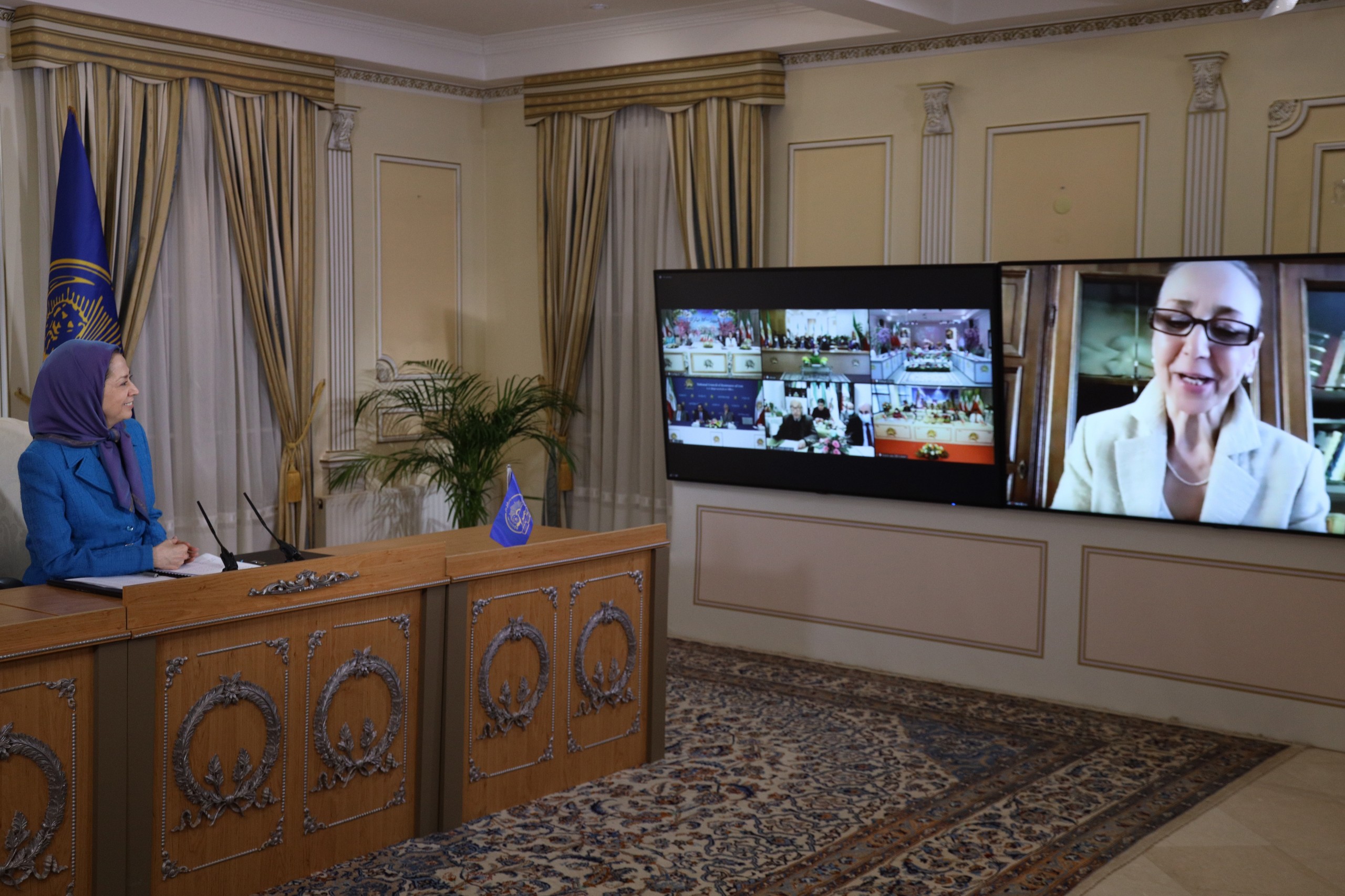
The clerical regime’s fatal paradox
Parallel to the evolution of the objective circumstances for the mullahs’ overthrow, the regime’s position has drastically weakened, to levels unprecedented in the past four decades. The regime is feeble and has depleted its reserves. It cannot regenerate vital resources, and there has been attrition among its suppressive forces due to pressures from social insurgencies. All these factors have pushed the regime to a point where whatever it does to preserve its rule will only exacerbate the volcanic conflicts brewing between the people and the ruling regime.
Let us examine some of the regime’s policies in several important areas, each of which arises from the regime’s fatal paradox.
Firstly, the regime stepped up attacks and missile launches against the U.S. bases in Iraq and the Saudi oil installations and airport facilities since the new U.S. President took office.
The clerical regime feels a need to launch these attacks to maintain its internal balance of power and pressure western parties to lift the sanctions. On the one hand, the continuation of such belligerence will make its position more unstable. On the other hand, if it were to retreat, it would lose one of its instruments for projecting power, which in turn would pave the way for losing its hold on power completely.
Secondly, regarding its nuclear program, the regime has resorted to measures such as higher uranium enrichment levels, production of uranium metal, which has no other application aside from being used in a nuclear weapon and leaving the Additional Protocol.
Such courses of action and efforts to build the bomb will lead to further sanctions and more international isolation for the regime. They will also exacerbate the existing contradictions between the people and the ruling regime while aggravating the regime’s internal feuds. On the other hand, by abandoning its nuclear program, the regime will be deprived of yet another instrument of power, which would erode the Velayat-e Faqih’s hegemony (absolute clerical rule), a red line for Khamenei.
This is where the regime’s fatal paradox becomes more apparent.
Thirdly, the issue of international sanctions, which has pushed the regime to the brink of suffocation, especially economically.
On the one hand, the lifting of the sanctions is an immediate need for the regime. A large segment within the regime, both publicly and privately, wants the sanctions lifted as soon as possible.
Earlier this month, the mullahs’ president, Hassan Rouhani, said: “We would not waste even a minute to have these oppressive sanctions lifted.”
On the other hand, however, Khamenei has boasted about the benefits of sanctions for the regime. Instead of demanding the lifting of sanctions, he said, “We must unleash our domestic force.” He emphasized that no one should “tie the country’s economy to the lifting of sanctions.”
Fourthly, the regime faces a paradox concerning relations with the U.S. On the one hand, the regime needs to have relations with the U.S. because of the JCPOA and lifting of the sanctions and other technological and industrial needs. On the other hand, it does not want to retreat from its major policies.
Long before the most recent U.S. elections, Khamenei and Rouhani harbored the illusion that they could return to the same balance of power that existed during Barack Obama’s presidency when they signed the 2015 JCPOA. However, as the NCRI Chairman Massoud Rajavi has pointed out: “After the uprisings in November 2019 and January 2020, Khamenei ran out of options, and his authority was shattered. Returning to the previous balance and the era of appeasement is nothing but a pipe dream, a mirage.”
Today, 2.5 months after the new U.S. President took office, Khamenei has had to step up the regime’s attacks against U.S. bases.
The fifth issue is the Iranian economy, which is crumbling, something that needs no explanation. The financial system is bankrupt, the pensioners’ funds are insolvent, the Social Security Organization is bankrupt, and the stock market is in free fall.
The regime’s experts say: “Setting aside any sort of propaganda, today, no one in Iran – neither Rouhani’s government nor the parliament or the Revolutionary Guard Corps (IRGC) – can save the country from the quagmire it has got itself stuck in.”
In such circumstances, Khamenei has two options: 1) Spend the country’s wealth and revenues to turn the wheels of production and create jobs and improve public welfare. In this case, he has to give up prioritizing the IRGC and his machinery of suppression, war, and terrorism and step into the path of reform, which will lead to the loss of his power. 2) Continue the status quo, where all options to pay for the regime’s expenses are similar to gasoline price hikes in November 2019; in other words, paying for these expenses out of the people’s pockets.
As Rouhani’s chief of staff confessed, increasing the exchange rate of foreign currency is a deliberate policy on the regime’s part. They also earn revenues from the stock market, which they claim is 14,000 trillion rials. Of course, this comes at the cost of leaving several million people defrauded and picking the pockets of tens of millions of people.
This unpopular policy has fueled the flames of discontent against the entire regime and is another example of its fatal paradox.
The reality is that even the import of vaccines, creating jobs, and providing bread and water for the people will be enough to shatter Khamenei’s hegemony, let alone the nuclear agreement, the missile program, or the lifting of the sanctions. This is the path he is treading on, where the contradiction between the society and the ruling regime gets further aggravated with every step.
Yes, to a democratically-elected Republic
The regime’s upcoming presidential election charade is yet another aspect of its fatal paradox.
To control the situation, Khamenei badly needs to install one of his own cronies as president to create a monolithic regime. Nevertheless, such change will render the regime more vulnerable vis-à-vis the disenchanted people. So, if Khamenei and the IRGC do not manage to implement this plan, the ruling clique would suffer a greater schism at the top, further undermining Khamenei’s hegemony.
But as far as the Iranian people, their Resistance, and the NCRI are concerned, the election sham is just a tool for covering up the ugly and murderous nature of religious fascism.
The clerical regime’s election is neither free nor congruent with any international standards. It does not enjoy any legitimacy among the public.
The NCRI has consistently boycotted all of the regime’s election charades over the past four decades and exposed the regime’s exaggerations of the turnouts. This time, too, the sham election held by the religious fascism will be rejected and boycotted nationwide.
Yes, our vote is the overthrow of the regime.
We say: No to religious fascism, yes to a democratically-elected republic.
Yes, to a pluralist republic based on free elections, separation of religion and state, gender equality, abolishing the death penalty, and eliminating all forms of discrimination against followers of various faiths, and autonomy for all ethnic groups.
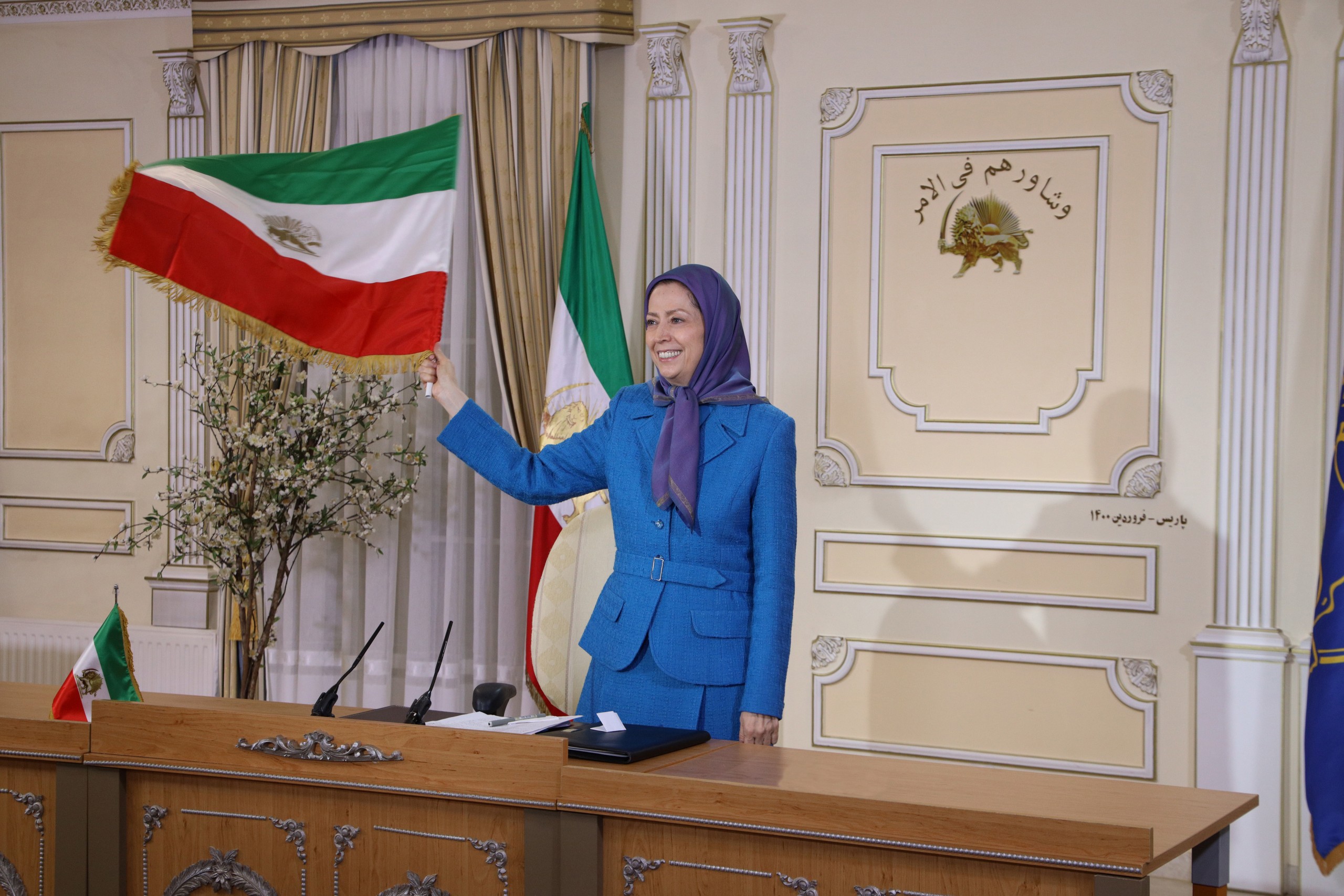
Advancement of the Resistance movement
The circumstances for a revolution and the overthrow of the regime have become visible in two significant areas:
First, in the expansion and endurance of Resistance Units and the ceaseless continuity of their activities in the last Persian Year of 1399. Despite all the blows and arrests, the number of Resistance Units and the quantity and quality of their activities to break the spell of repression have increased considerably.
The second domain where the circumstances for a revolution become perceptible relates to a beaming and radiating sole democratic alternative, i.e., the National Council of Resistance of Iran.
The political and international activities of the National Council of Resistance of Iran continued throughout the last year despite the restrictions caused by the Coronavirus pandemic, and the NCRI achieved remarkable successes.
The instructive revelations made by the NCRI exposed the plots and schemes by the clerical regime and its agents against the Iranian people’s Resistance. The NCRI’s holding of numerous international conferences, particularly the virtual annual gatherings of the Resistance, and the NCRI’s diplomatic activities and its efforts in international bodies for defending human rights, all attest to the Council’s impressive international standing.
A bipartisan resolution adopted last June by a majority of 222 members of the U.S. Congress as well as another resolution supported by 158 members of the new session of Congress, both of which supported the Iranian Resistance’s 10-point Plan and rejected the dictatorships of the Shah and the Sheikhs (mullahs) are very telling and instructive. Both resolutions state that “the people of Iran have rejected the monarchic dictatorship and are opposing the religious tyranny.”
On December 20, 2020, some 225 members of Khamenei’s parliament (Majlis) issued a statement showing their outrage over the international status of the PMOI and the National Council of Resistance of Iran (NCRI). They said: “The European Parliament has always supported and backed the PMOI and secessionist groups, and hosts the leaders of terrorist groups in this parliament and grants them freedom of activities.”
In the midst of all this, the arrest and conviction of the regime’s terrorist diplomat (Assadollah Assadi) and his three accomplices for attempting the terrorist bombing of the Resistance’s annual gathering (in 2018) was a watershed development. Notably, the documents seized indicated that other people were also directly receiving cash from Assadollah Assadi.
According to press reports, the police obtained a list of these individuals. In my Nowruz message, I pointed this out and said that we urge the relevant officials to go public with all the content, documents, names, and addresses they have obtained from the notebook belonging to the regime’s terrorist diplomat.
The collapse of phony alternatives
The NCRI owes its status more than anything to the confrontation between the Iranian society and the ruling religious fascism. The glorious uprising in November 2019 was the most critical development in this confrontation. It verified the validity and accuracy of the Iranian Resistance’s strategy for the regime’s overthrow on the ground and in the streets, leaving no room for phony alternatives and their adherents.
The uprising’s first political impact surfaced in the protesters’ chants of “we want neither the Shah nor the (mullahs’) leader” during the subsequent uprising in January 2020.
Throughout the Persian Year 1399 (March 2020 – March 2021), we saw the phony alternatives getting isolated in disgrace.
The mullahs exposed names of some of the agents hired and repeatedly used against the PMOI/MEK by the Intelligence Ministry. The mullahs’ Minister of Intelligence admitted that his ministry had ordered producing all the TV serials and movies against the PMOI. The mullahs’ Judiciary also dismantled one of the media outlets they had promoted as an opposition source by taking its director’s life.
Many claimants openly said that they preferred the current clerical regime over the National Council of Resistance of Iran. They clearly acknowledged that they are on the regime’s side in the fight between the regime and its opponents.
From the outset and in fact in his interviews in 1980, Massoud Rajavi said that during the anti-monarchic revolution –that due to 57 years of dictatorship by the Shah and his father who suppressed all freedoms and the expansion of (political) parties, thus preventing social consciousness– the people who chanted “death to the Shah” knew what they rejected. However, they did not precisely know what they wanted and what they must seek.
In his February 1986 message on the anniversary of the anti-monarchic revolution, Massoud Rajavi said: “The extraordinarily necessary and vast popular upheaval did not mature into an organized movement due to the masses’ insufficient level of awareness caused by half a century of the Pahlavi dictatorships. A revolutionary and popular organization that had the historical and social prospect for development and victory had been dismantled earlier by a group of so-called leftist opportunists and had yet to reorganize itself, an outcome that favored the Shah and his true heir, Khomeini. Therefore, there were no clear and profound demarcations between the revolution and the counter-revolution. While the general public knew what they did not want and who must be overthrown, they did not exactly know what they do want or what the characteristics and attributes of the alternative should be.”
The NCRI Chairman reiterated this realization in many of his messages, including in his message on February 11, 1998, where he said:
“The weakness of that stormy sea and those spontaneous feverish movements was a lack of depth and political awareness. Our people knew what they did not want. They did not want the Shah and his regime. However, they did not have a clear understanding of what they did want. This explains why the day after the fall of the Shah’s regime, many political claimants, and all sorts of profiteers and opportunists, entered the scene.”
Yes, 40 years after June 20, 1981, and a full-fledged resistance against the mullahs’ religious dictatorship with 120,000 martyrs, the massacre of political prisoners, and the uprisings in December 2017 and November 2019, now the vote of every Iranian is the regime’s overthrow. Again, for the nth time, we reiterate the motto we chanted just the day after June 20, 1981. We say: Yes to democratic change, democratic revolution, and a democratic republic!
In the 2018 annual gathering of the Iranian Resistance, I said that the roaring river of martyrs’ blood had left no historical space either for the mullahs or for the monarchical reactionary thought.
Now, if one can topple this regime without an organization and leadership, without overcoming grueling trials and tribulations, and without paying the price and making sacrifices, we say: Please, go ahead, do not delay.
If one can restore the people’s sovereignty without a history of fighting against two regimes, without drawing boundaries against dictatorship, subordination, and dependency, without waging a nationwide resistance and offering a galaxy of martyrs, without challenging the principle of the velayat-e faqih and phony regime “moderates,” we say: Please, go ahead, don’t delay.
If one can topple the mullahs without challenging Khomeini over the unpatriotic Iran-Iraq war, forcing an end to the inferno of that war, and discrediting the regime’s slogan of “liberating Qods (Jerusalem) via Karbala”; without compelling Khomeini to accept the ceasefire by launching 100 military operations by the National Liberation Army of Iran, which captured the city of Mehran and marched to the gates of Kermanshah; and without exposing the regime’s nuclear weapons, missile, chemical, and microbiological programs and facilities, yes, go ahead and don’t delay.
If one can leapfrog a fifty-year history overnight and create real change in Iran while dreaming about foreign support, and without having to expose the regime’s human rights abuses and crimes in 67 UN resolutions, without the campaign for justice for the massacred political prisoners in 1988, without campaigns by supporters of the Resistance worldwide and insisting on the rights of the Iranian nation for four decades, without having a specific platform and programs that the NCRI and the Provisional Government for the transition of sovereignty to the Iranian people have adopted, and finally without a tested leader, who has guided this ferocious struggle for five decades, if all this could instead be done overnight, we say: go ahead, the ball is in your court.
Over the past 40 years, all those aspiring opponents who were nonetheless unwilling to pay the price have had opportunities to test their luck. However, the complex realities and real experiences have shown that this dark and evil regime will neither be reformed nor turn “green” or “velvet.”
The overthrow of this regime inevitably requires a willingness to pay the necessary price. It requires the practice of honesty and sacrifice. It requires an organization and a sturdy political alternative, and it requires the organization of resistance units and an army of liberation.
Nevertheless, as Massoud Rajavi said in the context of evaluating the December 2017-January 2018 uprising: “We are not in competition with anyone seeking to assume power. On the other hand, and most certainly, no one can compete with the PMOI when it comes to practicing honesty, sacrifice, and paying the necessary price.”
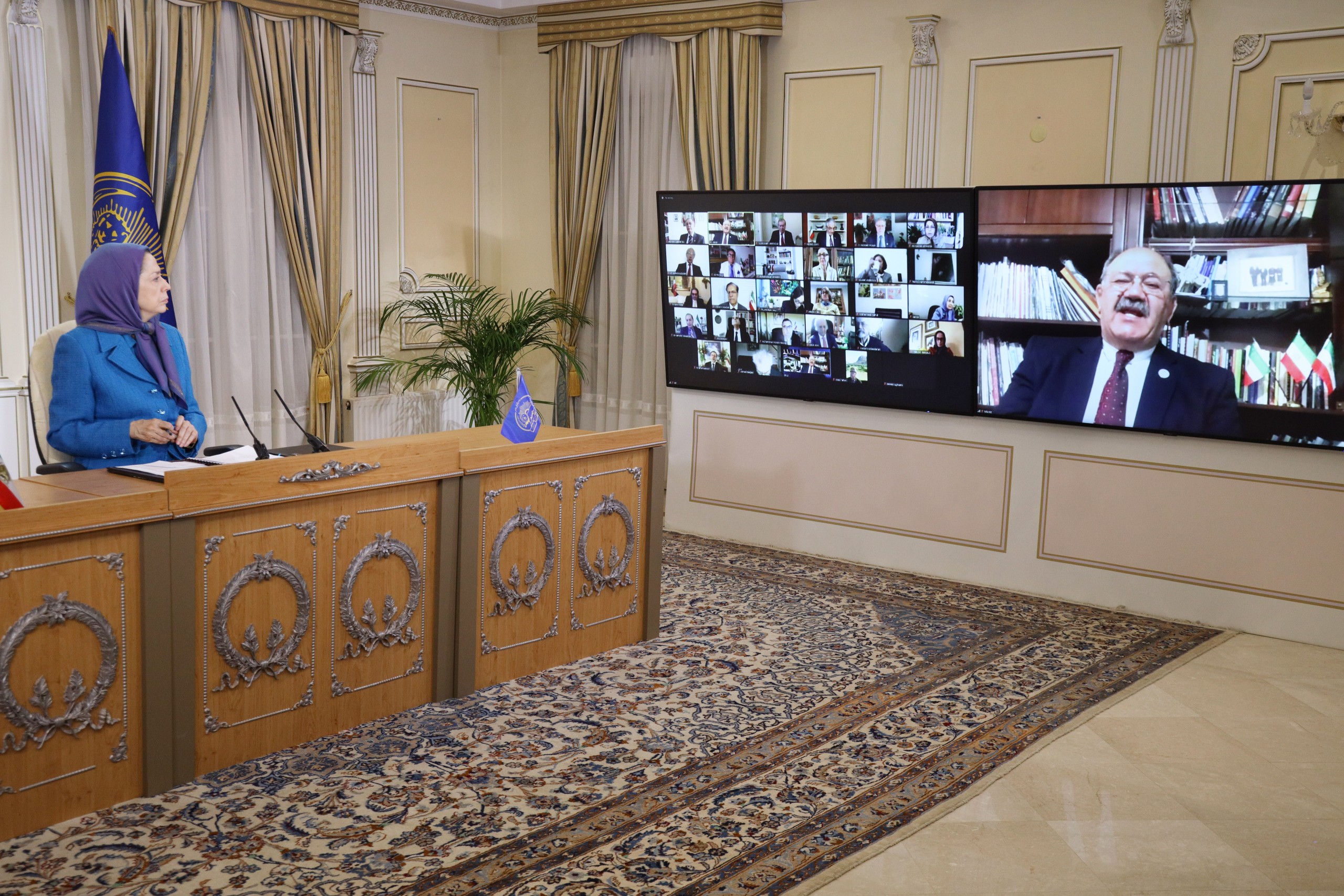
The role of the NCRI’s Chairman
The fitting impact of the National Council of Resistance is especially more pronounced thanks to the NCRI Chairman’s role.
In the last (Persian) year alone, he expounded and clarified in detail the most important developments related to Iran, ranging from the coronavirus pandemic to Khamenei’s policies and moves on domestic and international matters, thereby enlightening the youth in the battlefield as they struggle to overthrow the regime.
Massoud Rajavi revealed the regime’s ominous strategy on the coronavirus outbreak, indicating that “Khamenei wants to turn the coronavirus into a survival tool for the regime, but the people of Iran want the annihilation of the virus of religious dictatorship, and the children of Iran will uproot it.”
He called on everyone to boost their fighting spirit to rebel and fight 100 times more and take back Iran. He said if every death is an opportunity and a blessing for the Velayat-e Faqih regime, we must rise up and fight a hundred times more to turn every death into the countdown for uprising and the regime’s overthrow.
The NCRI Chairman showed the way, and by doing so, the Iranian Resistance capably proved that regarding the coronavirus outbreak, too, the NCRI is the regime’s main rival in defending the rights of the oppressed nation.
The NCRI Chairman reminded everyone about the assets and properties accumulated in the foundations and institutions under Khamenei’s control. He said these assets must be used to pay for the public’s hygiene and health care, and workers’ salaries. This call turned into a popular demand and even found its way to the ranks of the regime’s internal factions and the state media.
He advanced the majority of the Iranian people’s demands to disband the IRGC and use its budget and assets to confront the Coronavirus and provide for people’s health care and hygiene.
He said that the ruling religious fascism is like a predator devouring and massacring Iran’s people, resources, environment, and assets. They have auctioned the Caspian Sea and the Persian Gulf with its islands and fishing; they have destroyed the underground water reservoirs and brought about a water shortage crisis; they have destroyed the environment with their nuclear project; they have torched and burned down the jungles, and they have ruined our culture and literature.
In the face of the regime’s exercises in deception to deny its instability, the NCRI Chairman shed light on the following truth: There is no place in Khamenei’s calculations for the key and foundational factor represented by the people and the army of the hungry and deprived. However, Khamenei is gravely mistaken. Even if he were to muster the support of the U.S., Europe, China, and everyone else, as the Shah did, his overthrow and his regime’s downfall would still be inevitable.
Future prospects for Iran
Amidst the regime’s impasse where it has no solutions to offer, what direction will Iran’s circumstances take, and what are the prospects for the future? The answer is: The Iranian people and Resistance, the Resistance Units and the Army of Freedom, will have the final word.
The November 2019 uprising forged a sweeping and shining model that foretells how forces of rebellion and uprising will overthrow the regime.
The regime’s leaders and IRGC commanders are still frightened and asking each other how did Iranian protesters rise up instantaneously in 200 cities and attack 900 regime centers? How was it that everyone chose similar targets? How did they all use similar methods?
In reality, this force of rebellion and uprising is lurking in the heart of Iranian society. This force has grown from the seeds of sacrifice sewn in Iranian society by 120,000 martyrs who laid down their lives for the cause of freedom, as well as from the long, steadfast struggle of the PMOI and the NCRI. The force of rebellion in Iranian society is embodied in a knowledgeable and arisen generation guided by Resistance Units’ anti-repressive operations.
The NCRI is proud to have insisted on overthrowing the entirety of the clerical regime since its foundation four decades ago. The NCRI has constantly exposed and dashed the illusions about the regime’s potential to reform. It has always neutralized the false claims about the existence of so-called moderates and reformists within the religious fascism. In its proud existence, the NCRI personifies the Iranian people’s decisive NO to the Shah and the mullahs’ dictatorships.
I salute all the proud and honorable women and men who have risen to support the NCRI and its freedom-loving and democratic goals. I particularly hail the brave political prisoners who are persevering in Khamenei’s dungeons, those unsung heroes who have stood up to the regime and are the firm and resolute standard-bearers of the cause of freedom and equality for the people of Iran.
Thank you all very much.
